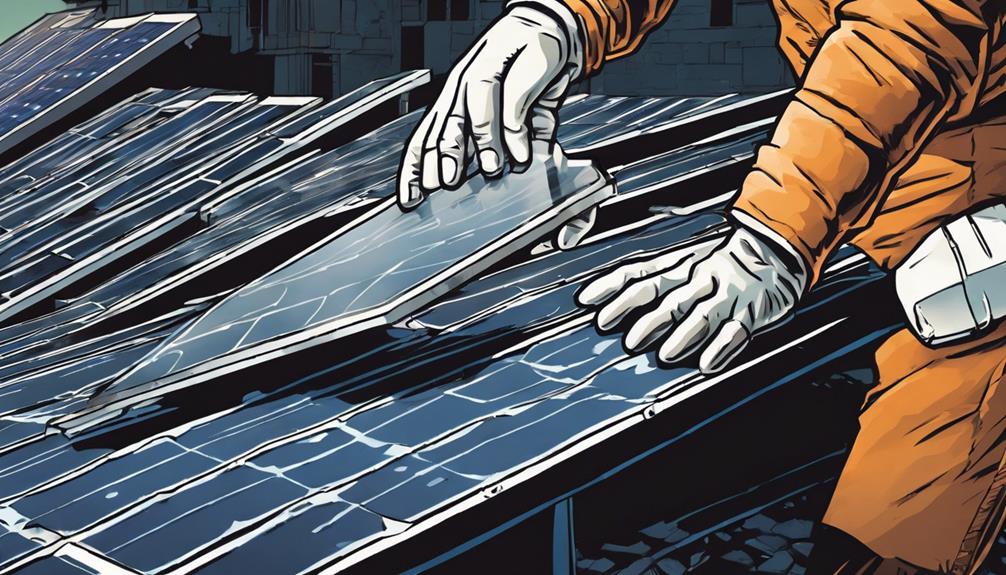When installing solar panels on your tile roof, you'll face unique challenges. The fragility of lightweight tiles and the weight of the panels require careful consideration. To guarantee a safe and efficient energy-harvesting system, you'll need to address these concerns head-on. You'll need to choose the right mounting method, such as comp-out or inset, and consider double flashing for a watertight seal. With the right approach, you can preserve your tiles, enhance stability, and maintain aesthetic appeal. As you explore the world of solar energy, you'll discover even more ways to harness the power of the sun.
Key Takeaways
- Preserve tiles by using tile replacement mounts or comp-out/inset methods to ensure a secure and watertight seal.
- Double flashing around solar panel penetrations is crucial to maintain a watertight seal and prevent water damage.
- Careful walking and handling during installation are essential to avoid damaging the tile roof and ensure a safe working environment.
- Conduct a thorough site assessment and roof preparation to identify potential issues and ensure a secure installation.
- Use high-quality flashing materials and follow electrical and fire safety standards to ensure a safe and compliant installation.
Challenges and Solutions

When installing solar panels on tile roofs, you'll encounter unique challenges that require specialized solutions to guarantee a safe and efficient setup. One major concern is the fragility of lightweight tile roofs, which can be vulnerable to damage from the weight of solar panels. To mitigate this risk, consider using comp-out or inset methods that preserve tile integrity.
Proper installation techniques are essential to prevent damage, leaks, and compromise of roof integrity. For clay tile roofs, specific considerations include double flashing and tile replacement mounts. By collaborating with experienced professionals, you can make sure a secure installation that meets your energy needs while protecting your roof.
Benefits and Best Practices

By opting for comp-out or inset solar installation on your tile roof, you can preserve your tiles, enhance stability, and maintain your home's aesthetic appeal. These methods guarantee a secure and watertight installation, protecting your roof from damage and leaks. Here are some best practices to contemplate:
| Best Practice | Description |
|---|---|
| Double Flashing | Guarantees a watertight seal around the solar panels |
| Secure Mounting | Prevents panel shifting and damage to the roof |
| Effective Waterproofing | Safeguards the roof from water damage and leaks |
| Careful Walking | Avoids damage to the roof and solar panels during installation |
Financial and Environmental Benefits
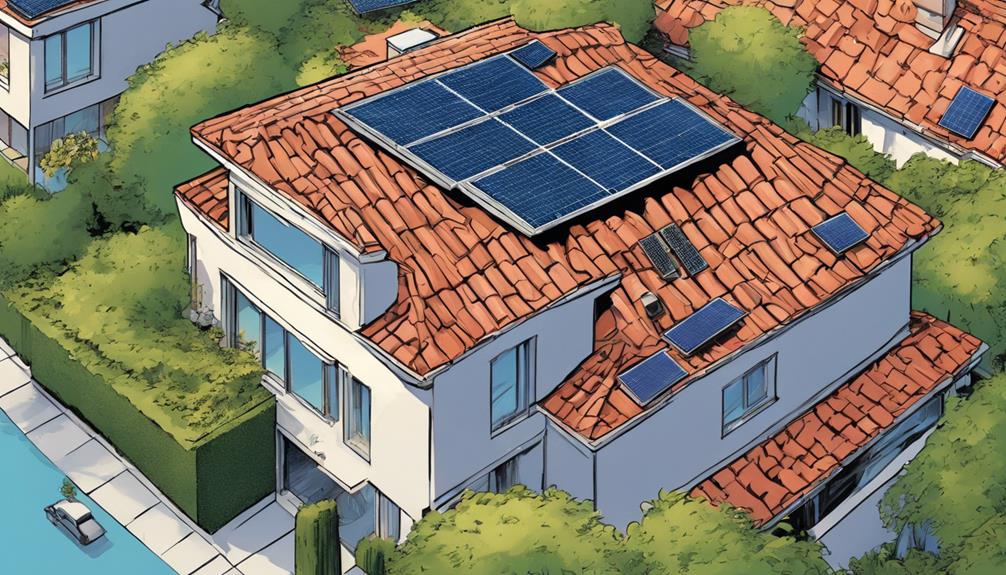
Despite higher upfront installation costs, you'll find that the long-term financial benefits of installing solar panels on your tile roof make it a worthwhile investment, with potential energy bill savings and a significant reduction in your carbon footprint.
By harnessing renewable energy, you'll enjoy energy independence and enhanced home aesthetics. Additionally, you may be eligible for solar tax credits, further increasing the return on your investment.
The environmental benefits are equally impressive, as solar energy generation reduces your reliance on fossil fuels and helps combat climate change. By combining solar panels with wind turbines, you can create a reliable and varied power supply, leading to even greater cost savings and a reduced carbon footprint.
Types of Wind Turbines
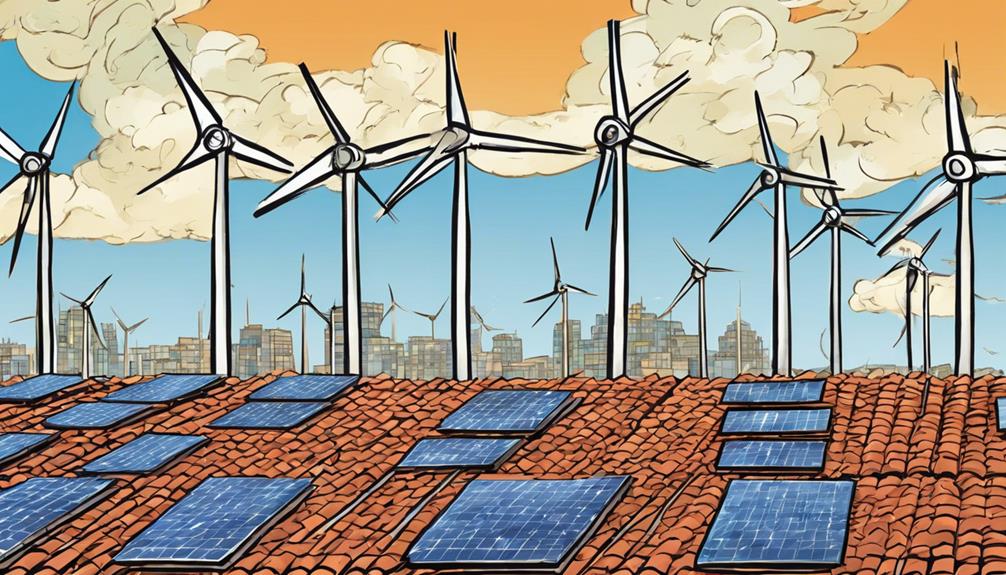
Your wind turbine options include horizontal axis and vertical axis turbines, each offering unique benefits that can enhance your energy generation and reduce your environmental impact.
Horizontal axis wind turbines are efficient, cost-effective, and renewable, with a smaller footprint. They're ideal for large-scale energy production and can be mounted on towers to capture stronger winds.
Vertical axis wind turbines, on the other hand, reduce noise pollution and are perfect for residential applications. They're also more aesthetically pleasing and can be installed in smaller spaces.
Expansion and Growth Potential
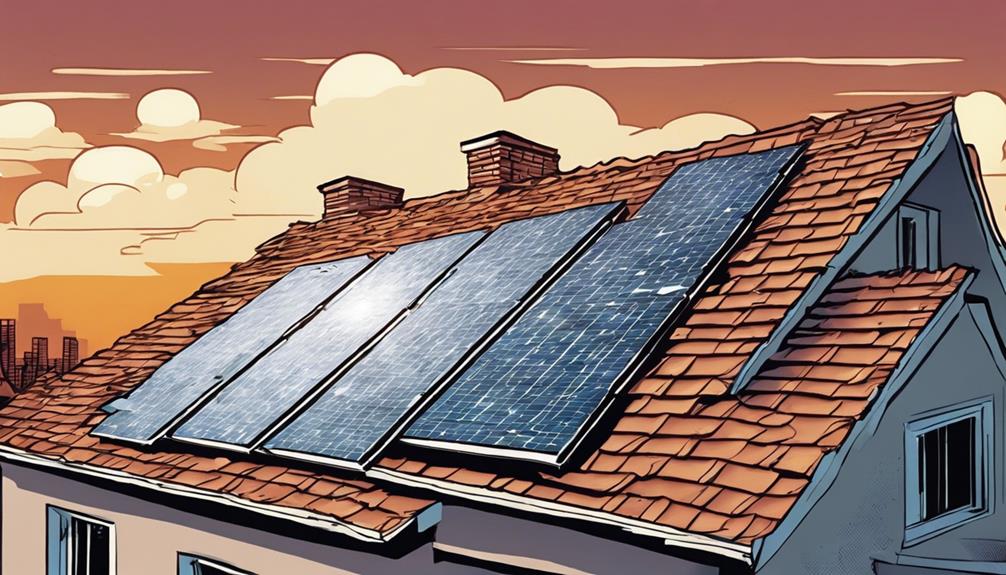
As you consider solar panel installation on your tile roof, you're likely wondering about the potential for expansion and growth, and the good news is that scalability is a significant advantage of renewable energy systems. You can start small and add more panels as needed, making it a cost-effective solution.
Energy storage solutions are also becoming more accessible, allowing you to store excess energy generated during the day for use at night or during power outages. Additionally, solar panels are effective in remote areas with limited access to traditional energy sources, making them an ideal solution for off-grid homes.
With the global push to combat climate change, the demand for solar energy is expected to continue growing, making it a worthwhile investment for your home and the planet.
Regulatory Compliance Matters
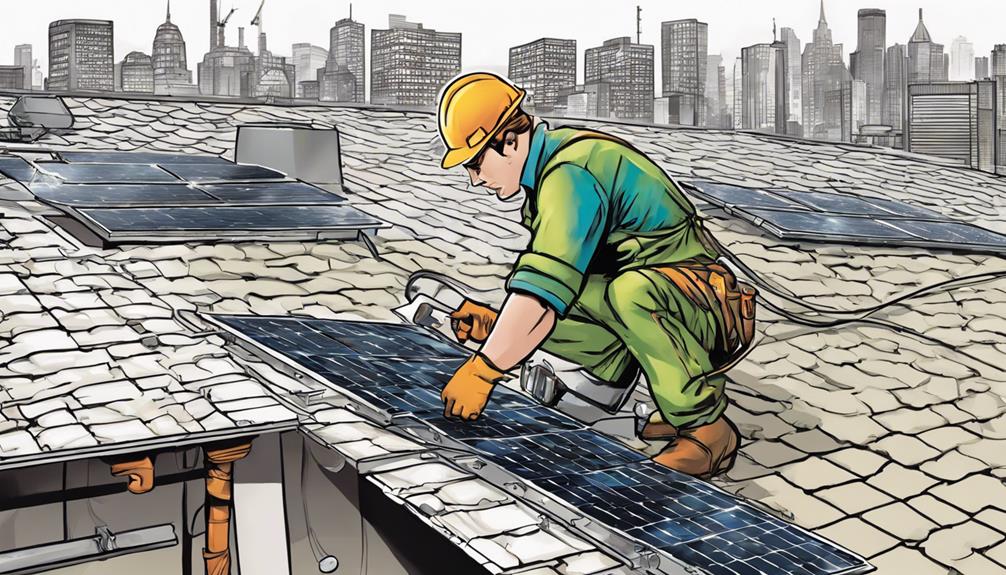
When installing solar panels on your tile roof, regulatory compliance is vital to avoid potential penalties, fines, or even system removal. It's crucial to make sure that your installation meets all relevant safety regulations and building codes. This includes obtaining necessary permits, meeting electrical and fire safety standards, and complying with local zoning laws.
To guarantee regulatory compliance, consider the following:
- Verify that your installer is licensed and certified
- Check if your system meets local building codes and safety standards
- Obtain necessary permits and approvals before installation
- Make sure compliance with electrical and fire safety regulations
- Review and understand local zoning laws and ordinances
Installation Process Essentials

With regulatory compliance in place, you're ready to start on the installation process, which involves several key steps to guarantee a successful and efficient solar panel installation on your tile roof.
| Step | Description | Importance |
|---|---|---|
| 1. Site Assessment | Evaluate your roof's condition, size, and orientation | Confirm feasibility and maximum energy output |
| 2. Roof Preparation | Clean and repair the roof, if necessary | Prevent damage and secure installation |
| 3. Panel Installation | Install solar panels using approved methods (e.g., comp-out or inset) | Ensure effective energy generation and durability |
| 4. Connection and Testing | Connect panels to the electrical system and test the installation | Confirm safe and efficient energy supply |
Combining Wind and Solar Energy
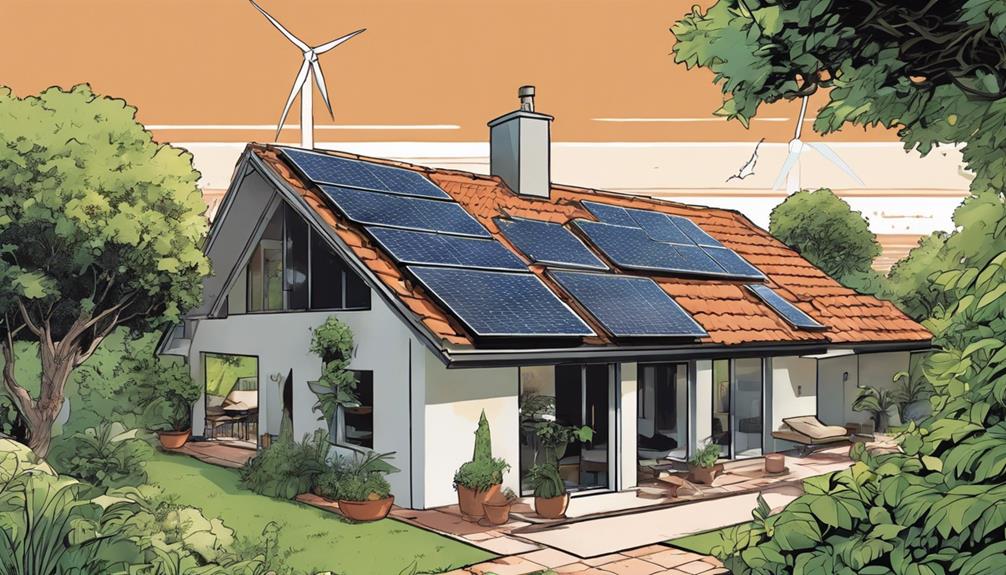
You can greatly enhance your renewable energy setup by combining wind and solar power, leveraging the strengths of both sources to guarantee a more reliable and efficient energy supply. This hybrid approach allows you to tap into the benefits of each energy source, ensuring a consistent flow of power even when one source is limited.
For instance:
- Increased energy production: Wind turbines can generate power during the night or on cloudy days, while solar panels can take over during sunny periods.
- Reduced reliance on fossil fuels: By combining wind and solar energy, you can significantly decrease your carbon footprint and reliance on non-renewable energy sources.
- Improved energy storage: Hybrid systems can store excess energy generated by either source, providing a backup power supply during periods of low energy production.
- Enhanced energy independence: Combining wind and solar energy gives you greater control over your energy needs, reducing your reliance on the grid.
- Long-term cost savings: Hybrid systems can provide substantial long-term savings, as you'll be generating your own clean energy and reducing your energy bills.
Frequently Asked Questions
Can Solar Panels Be Installed on Older Tile Roofs?
Yes, you can install solar panels on older tile roofs, but it's essential to assess the roof's condition and structural integrity first, ensuring it can support the added weight and installation methods.
How Do Weather Conditions Affect Solar Panel Performance on Tile Roofs?
"You wonder how weather conditions impact solar panel performance on tile roofs. Well, heavy rain, hail, and extreme temperatures can reduce efficiency, but quality panels and proper installation can mitigate these effects."
Are There Any Specific Local Building Codes for Tile Roof Solar Installations?
"As you envision your tile roof transformed into a clean energy hub, local building codes come into play. Yes, specific codes govern tile roof solar installations, ensuring structural integrity and safety in your area."
Can Solar Panels Be Removed and Reinstalled During Roof Repairs?
Yes, solar panels can be removed and reinstalled during roof repairs. You'll need to hire a professional to disconnect, remove, and store the panels, then reinstall them after repairs, ensuring a secure and waterproof seal.
What Is the Typical Warranty for Solar Panels on Tile Roofs?
You're wondering about the typical warranty for solar panels on tile roofs. Typically, solar panels come with a 25-year warranty, while the mounting system and installation labor usually have a 10-year warranty.
How Can Sunny Locations Benefit from Safely Installing Solar Panels on Tile Roofs?
Sunny locations can benefit from safely installing solar panels on tile roofs. Solar power innovations embrace these locations, tapping into their ample sunlight to generate clean and renewable energy. With the right installation, tile roofs can support solar panels, helping homes and businesses reduce their carbon footprint.
Conclusion
You've made it! Now, you're ready to bask in the glory of harnessing the limitless power of the sun, all while safeguarding your prized tile roof.
With the right expertise and materials, the seemingly challenging task of solar panel installation becomes a breeze.
So, go ahead, take the leap, and let the sweet melodies of energy independence and environmental stewardship serenade you for years to come.
